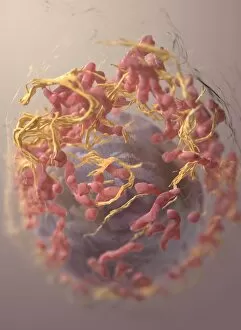Melanocyte Collection
Melanocytes, the pigment-producing cells in our skin, play a crucial role in determining our skin color
All Professionally Made to Order for Quick Shipping
Melanocytes, the pigment-producing cells in our skin, play a crucial role in determining our skin color. However they can not just responsible for giving us a beautiful complexion; they also have a dark side. Melanoma, the deadliest form of skin cancer, originates from these very cells. When viewed under an electron microscope (SEM C016 / 4764), melanoma cells appear sinister and menacing and can be seen invading healthy tissues, causing large eroded plaques on the leg with areas of crust. The sight of melanoma on a patient's skin is alarming and serves as a stark reminder of the dangers lurking beneath our epidermis. Intriguingly, scientists have managed to capture the three-dimensional structure of melanoma cells (3D structure of melanoma cell). This breakthrough has provided valuable insights into their behavior and potential vulnerabilities that could aid in developing effective treatments. Not all pigmented lesions are malignant though; some are benign dermal nevi that often elevate above the skin surface. These harmless growths serve as reminders that not every change in pigmentation should cause alarm. In recent years, researchers have been exploring innovative approaches to address various dermatological conditions related to pigmentation disorders. One such development is Afamelanotide (skin pigmentation drug F007 / 0096 & F007 / 0095), which holds promise for treating conditions like vitiligo or erythropoietic protoporphyria by stimulating natural pigment production. Microscopic examination further reveals the devastating effects of advanced stages of skin cancer (micrograph C015 / 7001 & C015 / 6050). These images highlight how imperative it is to detect and treat this disease early on when chances for successful intervention are higher. To better understand the intricate layers and structures within our largest organ -the skin- scientists employ scanning electron microscopy techniques (SEM) to examine detailed cross-sections (Skin section, SEM).








